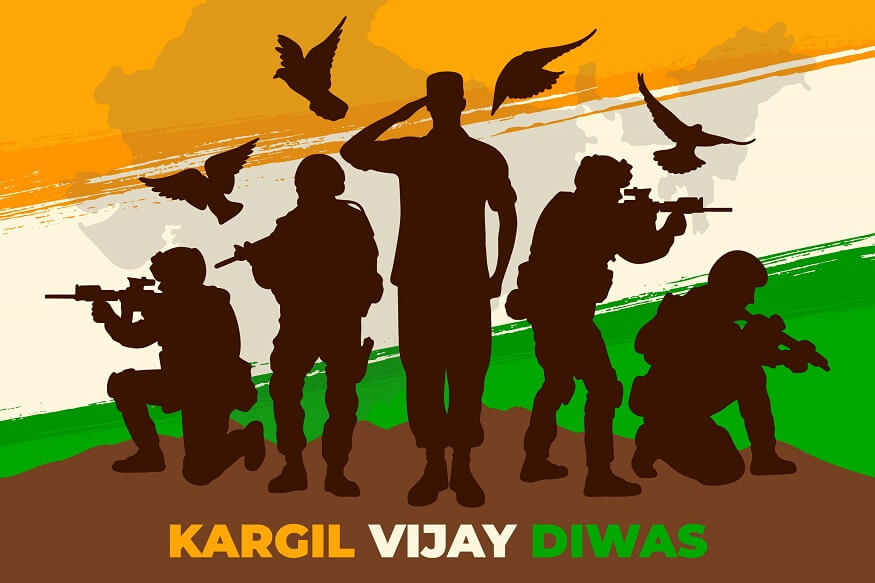The word Kargil arouses a mixed sense of pride and glum in the minds of all Indians. A valiant war was fought in Kargil where the brave Indian forces defeated the enemy Pakistani forces on the tumultuous 26th of July 1999. To commemorate this memorable victory of valour, July 26th is celebrated as Kargil Vijay Diwas every year wherein all Indians pay homage to the brave heroes of Kargil who sacrificed their lives for our great nation.
Below are some facts one needs to know about the War of Kargil and the heroes of that war.
Where is Kargil?
Kargil is a Ladakh district located 205 km east of Srinagar in the Indian state of Jammu and Kashmir (J&K). It is the second-largest town in the Ladakh region. Kargil is surrounded by the Indian state of Jammu and Kashmir towards its West and the Pakistani region of Gilgit Baltistan towards its North. Towards its east lies the Leh district of Ladakh, and the beautiful Indian state of Himachal State towards its South.
History of the War
The centre of this war was a 160 km stretch of the National Highway 1 (NH1) from Srinagar to Leh which cuts through Kargil. Long stretches of ridges and high posts exist for long stretches overlooking this very strategic highway, the only linkage between Srinagar and Leh. The height of the military outposts on these ridges was in the range of 16,000 to 18,000 feet. The war originated as a result of Pakistani forces, disguised as Kashmiri militants, occupying these military high-posts inside the Indian territory beyond the Line of Control (LOC). The Pakistani forces betrayed the bilateral agreement of certain posts being unattended during the winter season and took advantage of the melting snow and occupied those posts. As a retaliation, the Indian forces launched Operation Vijay, and Operation White Sea to win back the post and flush out the Pakistani soldiers from the region.
These occupied high posts being at an altitude overlooking the Indian territory gave a strategic advantage to the Pakistani troops. The war was fought for over sixty days from May to July of 1999, concluding on the 26th of July 1999. Post the war, the Pakistani army refused to accept any involvement of their forces in the occupation of these posts and blamed it on some unknown independent actors. They even refused to claim the corpses of the dead Pakistani soldiers who lost their lives during the war. It was the Indian forces who showed great professional courtesy and buried the Pakistani soldiers with full military honours. However, the documents found on the slain Pakistani soldiers and a statement made by Pakistan’s Prime Minister, Nawaz Sharif and their Chief of Army, Pervez Musharraf, made it amply clear that the insurgents were indeed Pakistani soldiers.
Heroes of the Kargil War
The 60-day Kargil War brought out the heroism of hundreds of Indian soldiers and a billion Indians across the country. While all those stories are invaluable there are a few stories of the Kargil war heroes which have left an indelible print on the minds and hearts of every Indian.
Captain Vikram Batra
Born in 1974, a Lieutenant in the 13th battalion of the Jammu and Kashmir Rifles, Captain Vikram Batra made the supreme sacrifice during the Kargil war. Barely 25 years of age, he was popularly known as Sher Shah and his war cry “Yeh Dil Maange More” achieved iconic status. He was awarded India’s highest gallantry honour, the Param Vir Chakra posthumously. Even the movie Shershaah was made based on the life of this Kargil war hero.
Grenadier Yogendra Singh Yadav
A nineteen-year-old boy in 1999, took 15 bullets while recapturing the Tiger hill on 4th of July 1999 along with his platoon. He risked his life to pave the way for his platoon to re-capture strategic posts atop Tiger Hill. Grenadier Yogendra Singh Yadav is the youngest to receive India’s top gallantry award, the Paramvir Chakra for his outstanding act of bravery and sacrifice.
Lieutenant Manoj Kumar Pandey
Another young 24-year-old didn’t shy away from enemy bullets and gave his life for his country and his battalion. He served in the 1/11 Gorkha Rifles and was posthumously awarded the Paramvir Chakra for his extreme act of sacrifice and valour.
The stories of such bravery are endless, Lieutenant Balwan Singh (Mahavir Chakra), Major Rajesh Singh Adhikari (Mahavir Chakra), Rifleman Sanjay Kumar (Paramvir Chakra), Major Vivek Gupta (Mahavir Chakra), Captain N Kenguruse (Mahavir Chakra), Lt. Keishing Clifford Nongrum (Mahavir Chakra), Naik Digendra Kumar (Mahavir Chakra), and the list goes on. Their sacrifices are supreme and fill our hearts with pride and gratitude and motivate us to give our best for the betterment of this great nation.
How is Kargil Vijay Diwas Celebrated?
Kargil Vijay Diwas is celebrated with great fanfare every year with the Prime Minister of India paying homage to the martyrs at the Amar Jawan Jyoti memorial at the India Gate in Delhi. A similar celebration and homage are paid at the Kargil War Memorial in the Dras sector at Tololing Hill. The Kargil War Memorial was constructed by the Indian Army in honour of the brave sacrifice of the 527 martyrs of the Kargil War. The popular poem “Pushp ki Abhilasha”, by Makhanlal Chaturvedi is engraved on the memorial along with the names of the 527 brave martyrs who lost their lives in the Kargil war.
Kargil Vijay Diwas is celebrated with vigour across the country, at army establishments, government offices, educational institutions, and in residential areas. Citizens pay homage to the Kargil war heroes, unfurl the Tiranga and sing the national anthem. Patriotic songs are played, patriotic movies are screened and veterans share stories of valour from the bravely fought Kargil war.
For more such informative blogs, please visit EuroSchool website.









